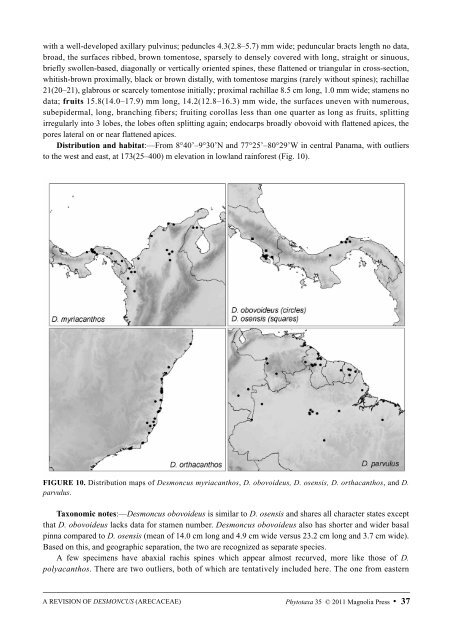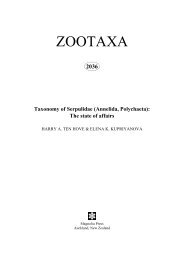You also want an ePaper? Increase the reach of your titles
YUMPU automatically turns print PDFs into web optimized ePapers that Google loves.
with a well-developed axillary pulvinus; peduncles 4.3(2.8–5.7) mm wide; peduncular bracts length no data,<br />
broad, the surfaces ribbed, brown tomentose, sparsely to densely covered with long, straight or sinuous,<br />
briefly swollen-based, diagonally or vertically oriented spines, these flattened or triangular in cross-section,<br />
whitish-brown proximally, black or brown distally, with tomentose margins (rarely without spines); rachillae<br />
21(20–21), glabrous or scarcely tomentose initially; proximal rachillae 8.5 cm long, 1.0 mm wide; stamens no<br />
data; fruits 15.8(14.0–17.9) mm long, 14.2(12.8–16.3) mm wide, the surfaces uneven with numerous,<br />
subepidermal, long, branching fibers; fruiting corollas less than one quarter as long as fruits, splitting<br />
irregularly into 3 lobes, the lobes often splitting again; endocarps broadly obovoid with flattened apices, the<br />
pores lateral on or near flattened apices.<br />
Distribution and habitat:—From 8°40’–9°30’N and 77°25’–80°29’W in central Panama, with outliers<br />
to the west and east, at 173(25–400) m elevation in lowland rainforest (Fig. 10).<br />
FIGURE 10. Distribution maps of Desmoncus myriacanthos, D. obovoideus, D. osensis, D. orthacanthos, and D.<br />
parvulus.<br />
Taxonomic notes:—Desmoncus obovoideus is similar to D. osensis and shares all character states except<br />
that D. obovoideus lacks data for stamen number. Desmoncus obovoideus also has shorter and wider basal<br />
pinna compared to D. osensis (mean of 14.0 cm long and 4.9 cm wide versus 23.2 cm long and 3.7 cm wide).<br />
Based on this, and geographic separation, the two are recognized as separate species.<br />
A few specimens have abaxial rachis spines which appear almost recurved, more like those of D.<br />
polyacanthos. There are two outliers, both of which are tentatively included here. The one from eastern<br />
A REVISION OF DESMONCUS (ARECACEAE)<br />
Phytotaxa 35 © 2011 <strong>Magnolia</strong> <strong>Press</strong> 37
















